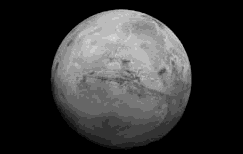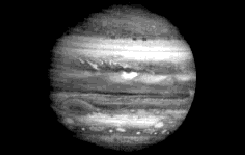
Viking Orbiter 1 took images of Mars in 1980 that wre used to compose this false-color mosaic.
Mars
Mars--the fourth planet, the Red Planet--has polar ice caps, and markings that looked, through 19th century telescopes, to be similar to human-made water canals on Earth. American and Russian orbiters did not disclose any canals on Mars, but they did find evidence of surface erosion and dried riverbeds, indicating the planet was once capable of sustaining liquid water. For millions of years, the Martian surface has been barren of water; Mars is too cool and its atmosphere is too thin to allow liquid water to exist. There is no evidence of civilizations, and it is unlikely that there are any extant life forms, but there may be fossils of life-forms from a time when the climate was warmer and liquid water existed.Mars is a small rocky planet. The surface of Mars retains a record of its evolution, including: volcanism, impact events, and atmospheric effects. Layered terrains near the Martian poles suggest that the planet's climate changes have been periodic, perhaps caused by a regular change in the planet's orbit. The crust of the planet seems to move vertically, with hot lava pushing upwards through the crust to the surface. Periodically great dust storms occur that engulf the entire planet. The effects of these storms are dramatic, including dunes, wind streaks, and wind carved features.
Mars has some remarkable geological characteristics including: the largest volcanic mountain, Olympus Mons (27 km high and 600 km across) in the solar system; volcanoes in the northern Tharsis region that are so huge they deformed the planet's spherical shape; and a gigantic equatorial rift valley, the Vallis Marineris. This canyon system could easily fit the Grand Canyon inside it and stretches the distance equivalent from New York to Los Angeles.

The U.S. Geological Survey produced this color enhanced image of Jupiter from a Voyager 1 image captured in 1979.
Jupiter
Jupiter, the fifth planet, is the largest planet, and contains two-thirds of the planetary mass of our solar system. Jupiter is like a small sun with its own miniature solar system; it is composed of hydrogen and helium and has 16 moons, as well as a thin, three-band ring system. Jupiter does not burn like the sun because it contains only one-eightieth of the mass needed to ignite its liquefied gas.Jupiter's atmosphere contains turbulent cloud layers of ammonia ice, ammonium-hydrogen sulfide crystals, and water ice or perhaps liquid water. The pressure of Jupiter's atmosphere is strong enough to form a layer of liquid metallic hydrogen capable of conducting huge electrical currents. The persistent radio noise and strong magnetic field of Jupiter could emanate from this layer of metallic liquid. Jupiter's magnetic field is immense, pouring billions of watts into Earth's own magnetic field every day. The atmosphere bristles with lightning and swirls with huge storm systems like the Great Red Spot, which have persisted for at least 100 years (and perhaps as long as 300 years).
Comet Shoemaker-Levy 9 struck Jupiter in July, 1994. Discovered in 1993, further observations of the comet revealed that it was in orbit around Jupiter, and had closely passed the giant planet in July, 1992. Jupiter's gravity broke the fragile comet into many chunks of dust and ice during this close approach. For the first time in history, scientists were able to predict that the comet would strike Jupiter and then watch the impact take place. The comet impact itself was a rare occurrence because comets of this size only strike Jupiter once in a millennium.